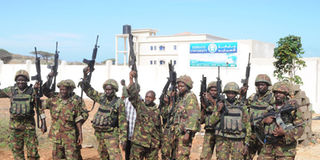What are Kenyan soldiers still doing in Somalia and is it worth the price?

KDF soldiers celebrate outside the Kismayo University after they took control from Al-Shabaab militia on Tuesday 2, 2012. Since Kenya’s army went into Somalia two years ago, the government has told Kenyans that they were going to war against al-Shabaab. PHOTO/FILE
What you need to know:
- Since Kenya’s army went into Somalia two years ago, the government has told Kenyans that they were going to war against al-Shabaab.
- But al-Shabaab retains control of most of Somalia and remains capable of striking Mogadishu, as well as Nairobi.
- The Westgate attack should spur Kenya’s leaders to re-think their approach towards Somalia.
The attack that killed more than 70 people at Nairobi’s Westgate shopping mall last week was, according to al-Shabaab, retribution for Kenya’s intervention in Somalia.
That raises a simple question: What is Kenya doing in Somalia, and is it worth the price?
Since Kenya’s army went into Somalia two years ago, the government has told Kenyans that they were going to war against al-Shabaab.
But that story was only partly true.
On the night of October 15, 2011, I lay awake listening to the Kenyan military convoys passing through the border town of Dadaab on their way to Somalia to launch the first foreign military campaign in Kenya’s history.
The proximate cause was the abduction of two Spanish aid workers from the vast refugee camps that encircle Dadaab.
For the Kenyan authorities, it was the final straw after a series of abductions of Westerners.
To stop the incursions, they launched what military leaders believed would be a quick campaign.
Over the last two years, some progress has been made.
The militants have been dislodged from the port of Kismayu, which was once their main base.
But al-Shabaab retains control of most of Somalia and remains capable of striking Mogadishu, as well as Nairobi.
Given this, if the Kenya Government’s aim was to destroy al-Shabaab, the intervention has been a spectacular failure.
But there is much more to the story.
In fact, retaliation against the militant group was little more than a convenient excuse to launch the so-called Jubaland Initiative, a plan to protect Kenya’s security and economic interests by carving out a semi-autonomous client state in southern Somalia.
While knowledge of the plan was initially confined largely to government officials, it was not long before its contours began to be revealed.
Kenya has installed a client regime in Kismayu, and has supported the new government in its quest to make Jubaland a semi-autonomous region, along the lines of Puntland, Somaliland, and the many other proto-states that emerged as Somalia unravelled.
Beyond preventing Somalia’s violence from spilling over into Kenya and undermining its security and its tourist-driven economy, such a buffer state could be forced to absorb the half-million Somali refugees who now live in Dadaab’s refugee camps.
In this sense, the Jubaland Initiative is a policy of stunning racial profiling – and a gift to al-Shabaab recruiters in Kenya.
Furthermore, contrary to claims that securing Kismayu put al-Shabaab at a disadvantage, the United Nations Monitoring Group on Somalia and Eritrea reported in July that the Kenyan Defence Forces have actually gone into business with al-Shabaab.
The group’s profits from illicit charcoal exported from Kismayu have grown since Kenya took control.
This highlights a fundamental problem: the Kenyan State’s endemic corruption constantly undermines its policymakers’ goals.
Indeed, in Kismayu, Kenyan officials have reverted to the pursuit of private profit.
Instead of working to achieve the diplomatic objective of defeating al-Shabaab, Kenya’s military, politicians and well-connected businessmen have been lining their own pockets.
Moreover, Kenya’s desire to carve out a buffer state conflicts with the Somali Government’s goal of uniting the country.
Indeed, the last thing Mogadishu wants is another semi-autonomous region challenging its authority.
The US and EU – which are bankrolling the African Union’s intervention in Somalia – have attempted to paper over the disagreement with Kenya over the Jubaland Initiative, despite its potential to fuel further conflict.
In fact, Jubaland forces clashed with Somali Government troops in Kismayu earlier this year.
The Westgate attack should spur Kenya’s leaders to re-think their approach towards Somalia.
A more coherent strategy would involve cutting off al-Shabaab’s funding and addressing the grievances – such as human-rights abuses against Somalis, discrimination against Muslims, foreign meddling in Somalia, and corruption – that motivate its recruits.
Given these intractable grievances – and, more important, the weakness and corruption of the Kenyan State – the cycle of violence will be very difficult to break.
That is why the attack on the Westgate mall is unlikely to be the last such tragedy.
Mr Rawlence, an Open Society Fellow, is the author of Radio Congo: Signals of Hope from Africa’s Deadliest War. (c): Project Syndicate, 2013. www.project-syndicate.org




